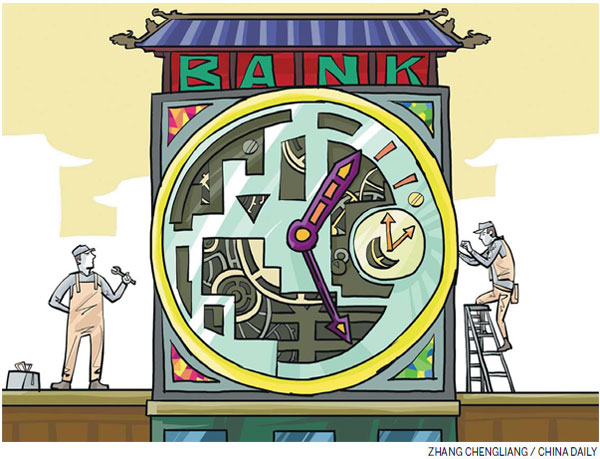Battling banks' biggest peril: No growth
Updated: 2015-06-12 06:39
By Steve Culp and Xiao Shaolin(China Daily Europe)
|
|||||||||||
Risk managers are playing a larger role in helping the banking industry reignite profitable expansion
For banks facing continuing market volatility and concerns regarding non-performing loans, risk management plays a double role. Defensive risk management - focused on regulatory compliance, controls and, basically, on staying out of trouble - remains vitally important. But more and more often risk management is playing an active role in helping banks identify and achieve growth.
Accenture's 2015 Global Risk Management Study, based on interviews with 470 top-level risk decision makers at banks, insurers and capital markets firms, found that banking respondents reported broad-based efforts to prepare the risk management function to play both roles.

Of those surveyed, 150 of the executives were based in the Asia-Pacific region. While almost eight in 10 respondents said they believe the risk function is a critical or important enabler of long-term profitable growth, there is more work to be done. Seventy-two percent of banking respondents said that gaining the trust of the business remains an obstacle to their effectiveness.
While all of the big five Chinese state-owned banks - Industrial and Commercial Bank of China, Bank Of China, Agricultural Bank of China, China Construction Bank and Bank of Communications - reported slower profit growth of less than 2 percent in the first quarter of this year, the big question for China's banks is how to make their business and operating models agile, flexible and suited for long-term profitable growth. To put it simply, the banks cannot achieve these objectives without the right risk management structures, people and processes in place. Respondents to the study indicated they are taking a number of actions to get risk management in shape for this challenge.
In particular, they say they are:
Working to identify new requirements for risk management and where they fall short;
Building closer working relationships between risk management and the rest of the business;
Investing in talent, particularly in digital disciplines such as analytics;
Enhancing the effectiveness of operational risk management;
Developing a consistent, enterprise-wide risk culture.
On both the defensive and the offensive sides of the risk management equation, banks also told Accenture that they are accelerating the adoption of analytics tools that make it easier to identify and mitigate risk in an increasingly complex market.
The new emphasis on the potential for risk management should not come as a surprise to bankers in China. Digital technologies, such as the cloud, lead to the rise of new competitive threats, with new digital players seeking to replace banks. We have found that customers of the traditional financial services industry, particularly younger generations, are increasingly willing to switch to new entrants if they offer the right services and provide them more quickly and inexpensively.
Consider China's e-commerce king Alibaba Group's Yu'ebao, which since 2013 has been providing online investment products that often come with fewer restrictions than many competing products from traditional banks. Since Yu'ebao's debut, several other Chinese Internet giants, such as Tencent and Baidu, have also jumped on the bandwagon, offering similar financial services. Even the e-commerce arm of electronics and home appliances retailer Suning is expected to launch a new company to attract its customers with personal loan and investment services.
The digital trends in consumer behavior and market competition are not unique to China. Our study of the North American banking market last year found that 72 percent of consumers aged 18 to 34 would probably bank with a technology, telecoms or retail company if it offered banking services. And, according to our estimates, up to one-third of global banks' revenues could be at risk by 2020 from these threats.
Chinese banks are very much aware of digital disruption: Since China's central bank issued the country's first business license for third-party payment services in 2011, the new ecosystem of payment services has been flooded with non-traditional players, including Internet companies, telecom carriers, retailers and smart device manufacturers. However, they are also active participants in the digital transformation of banking, offering mobile commerce solutions and other new unconventional platforms, as customer expectations are changing dramatically from the days of the traditional branch network.
Risk management in banks cannot stand back from this transition. It needs to play a leading role in assessing the opportunities and risks of this shift. Cementing relationships with new customers, protecting the bank from money laundering and terrorist financing are only a few areas where banks need to remain diligent as they move to a more virtual customer relationship.
Chinese banks should also embrace big data platforms and fully leverage digital technologies, such as interactive services and analytics to establish better governance of customer data. Such digital capabilities can integrate all customer data from traditional and digital channels of everyday consumption, household mortgages, personal financing and payments. It can provide explicit and comprehensive customer credit profiles to facilitate default risks prevention on one hand, and more insights on how to improve customer service with more secure, personalized offerings on the other.
The 2015 Global Risk Management Study also highlights the importance of better relationships between risk management and other bank functions. The relationship between risk management and finance is particularly important, and both functions need better coordination and consistency in the use of data and the application of tools and processes.
There are deeper concerns. For example, in the current regulatory environment, allocating enough capital to the right mix of products and geographies, while also investing in innovation and maintaining a balance between the risk and expected return is an ever-increasing challenge. Moving with speed and flexibility in a rapidly changing banking landscape requires risk and finance to work together dynamically.
Relationship issues extend beyond finance. Our survey respondents said that, out of all the executives in the C-suite, the chief risk officer is most likely to interact frequently with the CEO and with the chief security officer; CROs are least likely to interact frequently with business unit and/or regional heads, and with marketing. Improving the frequency and quality of these interactions is important to help ensure that risk management continues its journey to a more commercially focused role.
The risk management function has come a long way in a short time; the CRO now has a seat and a voice at the management table as well as greater authority in terms of protecting banks against identified and emerging risks. As our study shows, the next phase in the evolution of risk management will be to see if the function can solidify its place as an essential element in banks' growth and development process.
Steve Culp is senior managing director of Accenture Finance and Risk Services. Xiao Shaolin is a managing director for financial services of Accenture's Greater China business. The views do not necessarily reflect those of China Daily.
(China Daily European Weekly 06/12/2015 page12)
Today's Top News
Zhou Yongkang sentenced to life in prison
Kiev announces new round of peace talks on Ukraine crisis
Greece, EU powers agree to step up debt talks as crunch looms
EU sanctions hamper Italian-Russian commercial ties: Putin
Suu Kyi begins groundbreaking visit
G7 'ignore the facts over South China Sea'
British PM hails 'golden year' in UK-China relations
China's new rail giant bags first overseas deal from India
Hot Topics
Lunar probe , China growth forecasts, Emission rules get tougher, China seen through 'colored lens', International board,
Editor's Picks

|

|

|

|

|

|






